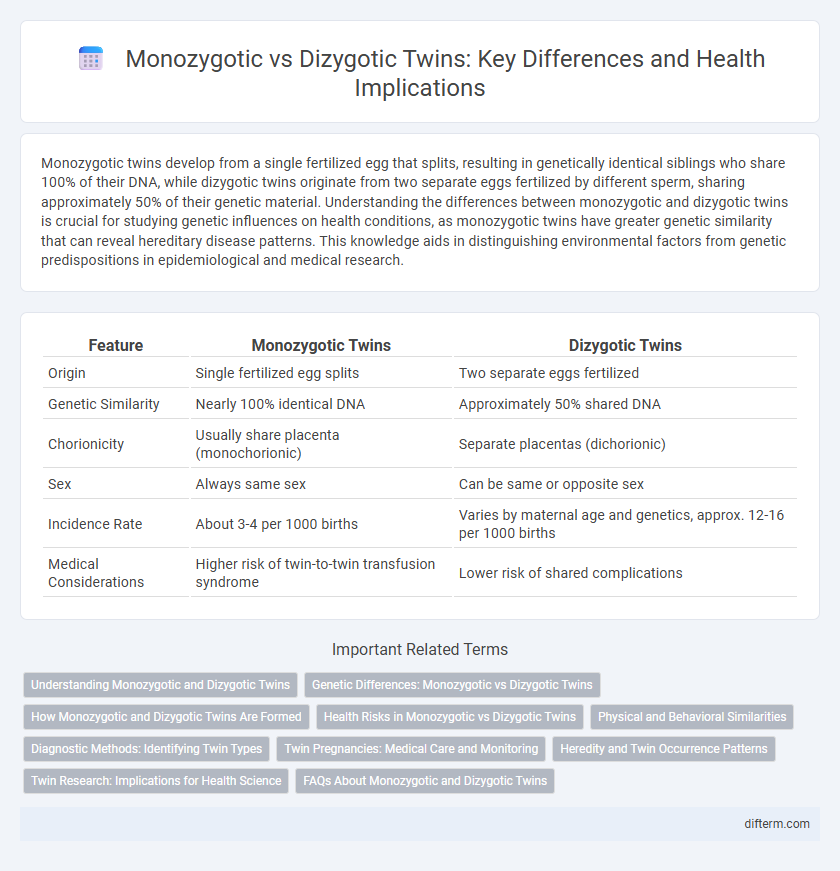Monozygotic twins develop from a single fertilized egg that splits, resulting in genetically identical siblings who share 100% of their DNA, while dizygotic twins originate from two separate eggs fertilized by different sperm, sharing approximately 50% of their genetic material. Understanding the differences between monozygotic and dizygotic twins is crucial for studying genetic influences on health conditions, as monozygotic twins have greater genetic similarity that can reveal hereditary disease patterns. This knowledge aids in distinguishing environmental factors from genetic predispositions in epidemiological and medical research.
Table of Comparison
| Feature | Monozygotic Twins | Dizygotic Twins |
|---|---|---|
| Origin | Single fertilized egg splits | Two separate eggs fertilized |
| Genetic Similarity | Nearly 100% identical DNA | Approximately 50% shared DNA |
| Chorionicity | Usually share placenta (monochorionic) | Separate placentas (dichorionic) |
| Sex | Always same sex | Can be same or opposite sex |
| Incidence Rate | About 3-4 per 1000 births | Varies by maternal age and genetics, approx. 12-16 per 1000 births |
| Medical Considerations | Higher risk of twin-to-twin transfusion syndrome | Lower risk of shared complications |
Understanding Monozygotic and Dizygotic Twins
Monozygotic twins originate from a single fertilized egg that splits into two genetically identical embryos, resulting in identical twins with nearly identical DNA. Dizygotic twins develop from two separate eggs fertilized by different sperm, leading to fraternal twins who share about 50% of their genetic material, similar to regular siblings. Understanding the genetic and developmental differences between monozygotic and dizygotic twins is crucial for studying hereditary health conditions and developmental biology.
Genetic Differences: Monozygotic vs Dizygotic Twins
Monozygotic twins originate from a single fertilized egg that splits, resulting in nearly identical genetic material shared between the twins. In contrast, dizygotic twins develop from two separate eggs fertilized by two different sperm, making their genetic similarity comparable to regular siblings, about 50%. The genetic identity in monozygotic twins provides a unique opportunity to study the influence of genetics versus environment in health research.
How Monozygotic and Dizygotic Twins Are Formed
Monozygotic twins form when a single fertilized egg splits into two embryos, resulting in genetically identical siblings sharing nearly 100% of their DNA. Dizygotic twins develop from two separate eggs fertilized by two different sperm cells, making their genetic similarity roughly 50%, equivalent to typical siblings. This fundamental difference in zygote formation explains variations in physical resemblance and genetic traits between monozygotic and dizygotic twins.
Health Risks in Monozygotic vs Dizygotic Twins
Monozygotic twins share identical genetic material, increasing the risk of hereditary diseases such as congenital heart defects and cystic fibrosis, compared to dizygotic twins who share about 50% of their genes. Monozygotic twins also face higher susceptibility to twin-to-twin transfusion syndrome and other prenatal complications due to shared placental structures. In contrast, dizygotic twins experience fewer genetically linked health risks but may still encounter typical twin pregnancy challenges like preterm birth and low birth weight.
Physical and Behavioral Similarities
Monozygotic twins share identical genetic material, resulting in remarkably similar physical traits such as eye color, height, and facial features, while dizygotic twins exhibit greater variability due to their genetic differences. Behavioral similarities, including intelligence, temperament, and risk of certain mental health disorders, tend to be more pronounced in monozygotic twins because of their shared genome. Research in twin studies consistently demonstrates higher concordance rates for physical characteristics and complex behaviors in monozygotic twins compared to dizygotic twins.
Diagnostic Methods: Identifying Twin Types
Diagnostic methods to differentiate monozygotic and dizygotic twins primarily involve genetic testing and ultrasound imaging. DNA analysis via short tandem repeat (STR) markers provides definitive identification by comparing genetic profiles, confirming monozygosity or dizygosity with high accuracy. Early prenatal ultrasound can suggest twin types based on chorionicity and amnionicity, but molecular techniques remain the gold standard for precise determination.
Twin Pregnancies: Medical Care and Monitoring
Twin pregnancies require specialized medical care and monitoring due to increased risks. Monozygotic twins, originating from a single fertilized egg, often share a placenta, leading to complications such as twin-to-twin transfusion syndrome that demand close ultrasound surveillance. Dizygotic twins, developing from two separate eggs, typically have separate placentas and generally present lower risk but still require frequent prenatal visits to monitor fetal growth and maternal health.
Heredity and Twin Occurrence Patterns
Monozygotic twins result from a single fertilized egg splitting, sharing 100% of their genetic material, which makes them crucial for studying hereditary traits and genetic disorders. Dizygotic twins develop from two different eggs fertilized by separate sperm, sharing approximately 50% of their genes, similar to regular siblings, providing insights into environmental versus genetic influences on health. The occurrence patterns vary, with monozygotic twinning being relatively constant worldwide, while dizygotic twinning rates fluctuate based on factors like maternal age, ethnicity, and fertility treatments.
Twin Research: Implications for Health Science
Monozygotic twins, sharing 100% of their genetic material, provide a unique model for studying the influence of genetics versus environment on health outcomes, whereas dizygotic twins share approximately 50% of their genes, similar to ordinary siblings. Twin research enables the disentanglement of hereditary factors from environmental influences in complex diseases such as diabetes, cardiovascular conditions, and mental health disorders. Findings derived from monozygotic and dizygotic twin studies drive advancements in personalized medicine and targeted prevention strategies by identifying genetic predispositions and modifiable risk factors.
FAQs About Monozygotic and Dizygotic Twins
Monozygotic twins, also known as identical twins, develop from a single fertilized egg that splits into two embryos, sharing nearly identical genetic material. Dizygotic twins, or fraternal twins, result from the fertilization of two separate eggs by two different sperm cells, making their genetic similarity comparable to regular siblings. Common questions about monozygotic and dizygotic twins often involve differences in physical appearance, likelihood of twinning within families, and variations in health risks between the two types.
Monozygotic vs Dizygotic Infographic

 difterm.com
difterm.com